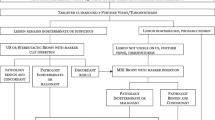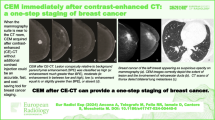Abstract
Objectives
To compare contrast-enhanced mammography (CEM) with low-energy image (LEI) alone and with magnetic resonance imaging (MRI) in the preoperative diagnosis of ductal carcinoma in situ (DCIS).
Methods
In this single-center retrospective study, we reviewed 98 pure DCIS lesions in 96 patients who underwent CEM and MRI within 2 weeks preoperatively. The diagnostic performances of each imaging modality, lesion morphology, and extent were evaluated.
Results
The sensitivity of CEM to DCIS was similar to that of MRI (92.9% vs. 93.9%, p = 0.77) and was significantly higher than that of LEI alone (76.5%, p = 0.002). The sensitivity of CEM to calcified DCIS (92.4%) was not significantly different from LEI alone (92.4%) and from MRI (93.9%, p = 1.00). However, CEM contributed to the simultaneous comparison of calcifications with enhancements. CEM had considerably higher sensitivity compared with LEI alone (93.8% vs. 43.8%, p < 0.001) and performed similarly to MRI (93.8%, p = 1.00) for noncalcified DCIS. All DCIS lesions were enhanced in MRI, whereas 94.9% (93/98) were enhanced in CEM. Non-mass enhancement was the most common presentation (CEM 63.4% and MRI 66.3%). The difference between the lesion size on each imaging modality and the histopathological size was smallest in MRI, followed by CEM, and largest in LEI.
Conclusion
CEM was more sensitive than LEI alone and comparable to MRI in DCIS diagnosis. The enhanced morphology of DCIS in CEM was consistent with that in MRI. CEM was superior to LEI alone in size measurement of DCIS.
Clinical relevance statement
This study investigated the value of CEM in the diagnosis and evaluation of DCIS, aiming to offer a reference for the selection of examination methods for DCIS and contribute to the early diagnosis and precise treatment of DCIS.
Key Points
• DCIS is an important indication for breast surgery. Early and accurate diagnosis is crucial for DCIS treatment and prognosis.
• CEM overcomes the deficiency of mammography in noncalcified DCIS diagnosis, exhibiting similar sensitivity to MRI; and CEM contributes to the comparison of calcification and enhancement of calcified DCIS, thereby outperforming MRI.
• CEM is superior to LEI alone and slightly inferior to MRI in the size evaluation of DCIS.





Similar content being viewed by others
Abbreviations
- BI-RADS:
-
Breast Imaging Reporting and Data System
- CC:
-
Craniocaudal
- CEM:
-
Contrast-enhanced mammography
- DCIS:
-
Ductal carcinoma in situ
- LEI:
-
Low-energy image
- MLO:
-
Mediolateral oblique
- MRI:
-
Magnetic resonance imaging
- NME:
-
Non-mass enhancement
- RCI:
-
Recombined image
References
Siegel RL, Miller KD, Jemal A (2016) Cancer statistics, 2016. CA Cancer J Clin 66:7–30
Siegel RL, Miller KD, Jemal A (2019) Cancer statistics, 2019. CA Cancer J Clin 69:7–34
Siegel RL, Miller KD, Wagle NS, Jemal A (2023) Cancer statistics, 2023. CA Cancer J Clin 73:17–48
Lalji UC, Jeukens CR, Houben I et al (2015) Evaluation of low-energy contrast-enhanced spectral mammography images by comparing them to full-field digital mammography using EUREF image quality criteria. Eur Radiol 25:2813–2820
Lee-Felker SA, Tekchandani L, Thomas M et al (2017) Newly diagnosed breast cancer: comparison of contrast-enhanced spectral mammography and breast MR imaging in the evaluation of extent of disease. Radiology 285:389–400
Mori M, Akashi-Tanaka S, Suzuki S et al (2017) Diagnostic accuracy of contrast-enhanced spectral mammography in comparison to conventional full-field digital mammography in a population of women with dense breasts. Breast Cancer 24:104–110
Jochelson MS, Dershaw DD, Sung JS et al (2013) Bilateral contrast-enhanced dual-energy digital mammography: feasibility and comparison with conventional digital mammography and MR imaging in women with known breast carcinoma. Radiology 266:743–751
Cheung YC, Lin YC, Wan YL et al (2014) Diagnostic performance of dual-energy contrast-enhanced subtracted mammography in dense breasts compared to mammography alone: interobserver blind-reading analysis. Eur Radiol 24:2394–2403
Tennant SL, James JJ, Cornford EJ et al (2016) Contrast-enhanced spectral mammography improves diagnostic accuracy in the symptomatic setting. Clin Radiol 71:1148–1155
Fallenberg EM, Schmitzberger FF, Amer H et al (2017) Contrast-enhanced spectral mammography vs. mammography and MRI - clinical performance in a multi-reader evaluation. Eur Radiol 27:2752–2764
Qin Y, Liu Y, Zhang X et al (2020) Contrast-enhanced spectral mammography: a potential exclusion diagnosis modality in dense breast patients. Cancer Med 9:2653–2659
Vignoli C, Bicchierai G, De Benedetto D et al (2019) Role of preoperative breast dual-energy contrast-enhanced digital mammography in ductal carcinoma in situ. Breast J 25:1034–1036
Cheung YC, Chen K, Yu CC, Ueng SH, Li CW, Chen SC (2021) Contrast-enhanced mammographic features of in situ and invasive ductal carcinoma manifesting microcalcifications only: help to predict underestimation? Cancers (Basel) 13:10
Shin HJ, Choi WJ, Park SY et al (2022) Prediction of underestimation using contrast-enhanced spectral mammography in patients diagnosed as ductal carcinoma in situ on preoperative core biopsy. Clin Breast Cancer 22:e374–e386
Ursin G, Ma H, Wu AH et al (2003) Mammographic density and breast cancer in three ethnic groups. Cancer Epidemiol Biomarkers Prev 12:332–338
Preibsch H, Beckmann J, Pawlowski J et al (2019) Accuracy of breast magnetic resonance imaging compared to mammography in the preoperative detection and measurement of pure ductal carcinoma in situ: a retrospective analysis. Acad Radiol 26:760–765
Baur A, Bahrs SD, Speck S et al (2013) Breast MRI of pure ductal carcinoma in situ: sensitivity of diagnosis and influence of lesion characteristics. Eur J Radiol 82:1731–1737
Cheung YC, Juan YH, Lin YC et al (2016) Dual-energy contrast-enhanced spectral mammography: enhancement analysis on BI-RADS 4 non-mass microcalcifications in screened women. PLoS One 11:e0162740
Hofvind S, Iversen BF, Eriksen L, Styr BM, Kjellevold K, Kurz KD (2011) Mammographic morphology and distribution of calcifications in ductal carcinoma in situ diagnosed in organized screening. Acta Radiol 52:481–487
Jansen SA, Newstead GM, Abe H, Shimauchi A, Schmidt RA, Karczmar GS (2007) Pure ductal carcinoma in situ: kinetic and morphologic MR characteristics compared with mammographic appearance and nuclear grade. Radiology 245:684–691
Rosen EL, Smith-Foley SA, DeMartini WB, Eby PR, Peacock S, Lehman CD (2007) BI-RADS MRI enhancement characteristics of ductal carcinoma in situ. Breast J 13:545–550
Chan S, Chen JH, Agrawal G et al (2010) Characterization of pure ductal carcinoma in situ on dynamic contrast-enhanced MR imaging: do nonhigh grade and high grade show different imaging features? J Oncol 2010:431341
Greenwood HI, Heller SL, Kim S, Sigmund EE, Shaylor SD, Moy L (2013) Ductal carcinoma in situ of the breasts: review of MR imaging features. Radiographics 33:1569–1588
Bijker N, Peterse JL, Duchateau L et al (2001) Risk factors for recurrence and metastasis after breast-conserving therapy for ductal carcinoma-in-situ: analysis of European Organization for Research and Treatment of Cancer Trial 10853. J Clin Oncol 19:2263–2271
Marcotte-Bloch C, Balu-Maestro C, Chamorey E et al (2011) MRI for the size assessment of pure ductal carcinoma in situ (DCIS): a prospective study of 33 patients. Eur J Radiol 77:462–467
Menell JH, Morris EA, Dershaw DD, Abramson AF, Brogi E, Liberman L (2005) Determination of the presence and extent of pure ductal carcinoma in situ by mammography and magnetic resonance imaging. Breast J 11:382–390
Cheung YC, Tsai HP, Lo YF, Ueng SH, Huang PC, Chen SC (2016) Clinical utility of dual-energy contrast-enhanced spectral mammography for breast microcalcifications without associated mass: a preliminary analysis. Eur Radiol 26:1082–1089
Patel BK, Garza SA, Eversman S, Lopez-Alvarez Y, Kosiorek H, Pockaj BA (2017) Assessing tumor extent on contrast-enhanced spectral mammography versus full-field digital mammography and ultrasound. Clin Imaging 46:78–84
Lobbes MB, Lalji UC, Nelemans PJ et al (2015) The quality of tumor size assessment by contrast-enhanced spectral mammography and the benefit of additional breast MRI. J Cancer 6:144–150
Acknowledgements
Thanks to all participants in this study.
Funding
The authors state that this work has not received any funding.
Author information
Authors and Affiliations
Corresponding author
Ethics declarations
Guarantor
The scientific guarantor of this publication is Qinglin Yang.
Conflict of interest
The authors of this manuscript declare no relationships with any companies, whose products or services may be related to the subject matter of the article.
Statistics and biometry
One of the authors has significant statistical expertise.
Informed consent
Written informed consent was waived by the Institutional Review Board.
Ethical approval
Institutional Review Board approval was obtained.
Study subjects or cohorts overlap
No study subjects or cohorts have been previously reported.
Methodology
• retrospective
• diagnostic or prognostic study
• performed at one institution
Additional information
Publisher's Note
Springer Nature remains neutral with regard to jurisdictional claims in published maps and institutional affiliations.
Liping Wang, Ping Wang, and Huafei Shao are co-first authors on the paper.
Supplementary Information
Below is the link to the electronic supplementary material.
Rights and permissions
Springer Nature or its licensor (e.g. a society or other partner) holds exclusive rights to this article under a publishing agreement with the author(s) or other rightsholder(s); author self-archiving of the accepted manuscript version of this article is solely governed by the terms of such publishing agreement and applicable law.
About this article
Cite this article
Wang, L., Wang, P., Shao, H. et al. Role of contrast-enhanced mammography in the preoperative detection of ductal carcinoma in situ of the breasts: a comparison with low-energy image and magnetic resonance imaging. Eur Radiol (2023). https://doi.org/10.1007/s00330-023-10312-z
Received:
Revised:
Accepted:
Published:
DOI: https://doi.org/10.1007/s00330-023-10312-z




